Design Thinking in Schools: An Emerging Movement Building Creative Confidence in our Youth
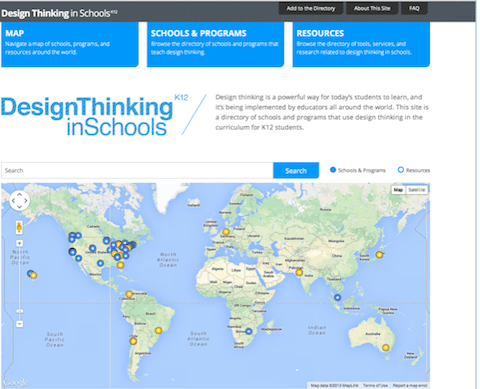
By Sandy Speicher
A few years ago I interviewed a group of high school students who had just taken a semester-long “Introduction to Design Thinking” course. In the class, they did a series of projects with increasing complexity in order to learn the process of design. I asked Andrew, a freshman, to name his favorite project from the class. Without pause, he answered, the first one — designing a name badge for someone else.
I was surprised to hear Andrew’s response, as I tend to think big in terms of the potential for design thinking. I believe that design can help address the world’s greatest challenges, and frankly, I wasn’t quite sure why the teacher had opted to include something as seemingly mundane as designing a name badge. Intrigued, I asked Andrew to tell me some of the reasons he liked that project so much.
Until that project, Andrew explained, he had never realized that he could create something that would make someone else happy. He expressed how good it felt to realize that creating something of value for someone else was within his ability. Andrew said that he had learned new things about himself: he could be a leader, he could effect someone else’s experience, he could listen to their needs and interests and make something meaningful from it.
Impressed, I expanded on the question, “Based on your experience with that project, what’s something else you’d like to design?” Andrew looked up to the sky, thought for a few seconds, and said, “Well, the state economy of Michigan could use some help. And the school cafeteria. I’d like to redesign the school cafeteria.”
What is design thinking? Loosely put, design thinking is a set of tools, methods, and processes by which we develop new answers for challenges, big and small. Through applying design thinking to challenges, we learn to define problems, understand needs and constraints, brainstorm innovative solutions, and seek and incorporate feedback about our ideas in order to continually make them better. The more we apply design thinking to the challenges we see, the deeper we strengthen the belief in our ability to generate creative ideas and make positive change happen in the world.
Many educators and school leaders are working to integrate design thinking into their classrooms, and here at IDEO and the K–12 Lab Network at Stanford’s d.school, we have been a part of making some of these programs happen. In the last few years, we have seen an enormous increase in inquiries about how design thinking is being used in schools. Parents want creative-confidence-building programs for their kids. Teachers are looking for inspiration around curriculum and for communities of like-minded educators with whom they can share ideas and collaborate. School leaders are asking for creative ways to integrate design thinking as a long-term strategy.
Mapping a global movement. A global movement is unfolding, and in response to the overwhelming interest around design thinking in schools, IDEO and the d.school have created a new directory — Design Thinking in Schools — to highlight the network of institutions that are at the forefront of this movement.
The directory, launched in mid-October, already features a wide range of programs and resources. There’s a mix of learning environments, from charter and district public schools to museums and summer camps. The programs are diverse, including after school “lab” environments and schools that use design thinking as the basis for subject-matter courses. Some programs offer workshops and training to organizations researching educational outcomes associated with design thinking. The programs’ offerings also come from all over the world, from Ahmedabad to Auburn Hills, from Singapore to Spokane.
If your school or program is already teaching design thinking to youth, please add yourself or your organization to the directory. If you are interested in finding a program or resources to help integrate design thinking in your school, the directory offers a great set of organizations already listed for inspiration and new connections.
The need for design thinking. This movement to build a generation of design thinkers could not be more timely or more relevant. We are living in an age of increased complexity, and are facing global challenges at an unprecedented scale. The nature of connectivity, interactivity, and information is changing at lightening speed. We need to enable a generation of leaders who believe they can make a difference in the world around them, because we need this generation to build new systems and rebuild declining ones. We need them to be great collaborators, great communicators, and great innovators.
As we help today’s students build their foundation of core academic knowledge and skills, we also need to look at the ways we are helping our youth build their confidence in their abilities to create. From name badges to state economies, we need our youth to know that they can empathically and intelligently shape the world. We need to help them develop the tools to create change.
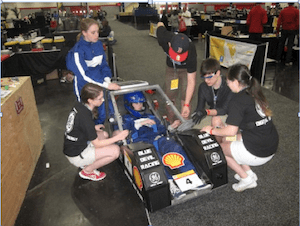
At the New York district public school of Brockport High, students can enroll in an engineering design and development course where they use design thinking to apply their knowledge of math, science, and engineering to solve real-world problems.
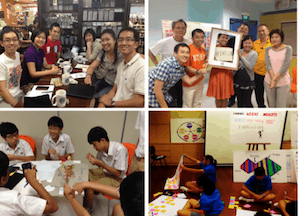
The Victoria-Cedar Alliance in Singapore offers a six-year Imagineering Program leading to a certificate. Through design thinking, the Imagineering Program helps students gain a deeper understanding of social issues, develop empathy with people in the community, and cultivate a passion for improving the lives of others.

Design for Change is a contest for middle school children. By empowering students to identify the challenges that most affect their communities, Design for Change encourages kids to find the solutions and lead adults and their classmates in the effort. Design for Change began in 2009 at Riverside School in Ahmedabad, India, and now reaches students in more than 200,000 schools across the world.
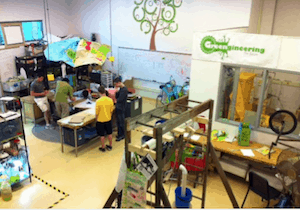
In Massachusetts, Newton North High School offers a Greengineers program in which design thinking is the basis for a collaborative think-tank. The effort combines diverse content areas such as chemistry, engineering, physics, economics, finance, fashion, and industrial safety.

The Ellis School, an independent school in Pittsburgh, PA integrates design thinking into several courses such as Introduction to Engineering Design, Physics, and Computer Science. Recently, students at Ellis used design thinking as a school-wide initiative to find and answer problems related to girls’ education throughout the world.
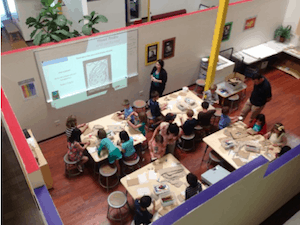
Synapse School, an independent K-8 school in California, combines design thinking with a constructivist-learning framework. Students as young as kindergarten use design thinking in their projects, and take a class that specifically helps them learn design process.
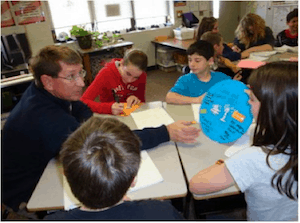
Swansboro Elementary School, a district public school in North Carolina, is exploring the integration of design thinking and the Common Core standards. The school’s goal for students to use knowledge, understanding, and design thinking methods as a way to develop a strong emphasis on empathy and problem-solving and to grow socially, academically, physically, and emotionally.
Sandy Speicher is an associate partner at the global design and innovation firm IDEO, where she leads the Education practice. She and her teams have helped create a scalable, affordable education system in Peru, strategies to improve schools for the poor in India, digital learning platforms that meet the needs of today’s students, and approaches to increasing teaching effectiveness in the US. Prior to IDEO, Sandy taught visual communications at Washington University in St. Louis, Missouri, and spent six years teaching design thinking to fifth-graders at a public school in San Francisco.






Ed Jones
Sandy, thank you very much for this. I hate to admit that I needed a good introduction, but I did. You've grabbed my attention.
Could you tell me, if I were talking with my friend the asst principal at the local school--where they still maintain a relatively traditional course schedule, with a few AP classes, a first rate speech and debate program as well as choral/drama, one art teacher, are rated A+ in the state's new A-F system--what students a design thinking class should be aimed at? And who should teach it?
Thanks,
Sandy Speicher
Hi Ed-
Thanks for your question! Glad to hear that this post piqued your interest.
You've asked a really great question that I'm sure a lot of people are wondering too. The truth is, one of the reasons we created the Design Thinking in Schools directory is because we've seen schools and programs that are all teaching design thinking in entirely different ways. Some elementary schools are integrating design thinking into their classrooms, some middle schools are doing semester-long challenges with students, some high schools have after-school programs where students choose real-world problems to apply their academic knowledge to. The great thing is that when given a design question -- How might we redesign a name badge?, or How might we redesign the state economy of Michigan? -- all that you've been learning can come into play. Through design questions, students can practice applying their knowledge, while building some of those great, needed skills of creativity, collaboration, empathy, communication, planning, project management, etc.
We have also seen teachers of all ages and subject matter turn their attention toward design thinking. In my experience so far, generally we see a teacher "flip" -- realizing that challenge-based learning a great way to learn many things (not to mention makes teaching lots of fun!), and they start to integrate these practices in their classrooms, or their schools. For a school like you're describing it might be great to consider an after school program or a lab which allows for a lot more flexibility in terms of the kinds of projects and learning experiences.
The great thing is that there's not one perfect model. And so we all get to learn from what each other are doing.
My suggestion would be to look through the directory (www.designthinkingforeducators.org) with your friend, and see what kind of programs or projects feel exciting to her/him. Reach out to other schools to learn about what they've done. Or grab some of the resources on the site to get started. There are many programs, teacher training organizations, contests, etc... that have already added themselves to the directory. We hope that it keeps building so that you can find the kind of inspiration you're looking for.
Sandy
Lisa Abel-Palmieri
Sandy,
Thank you for mentioning our work at The Ellis School in your post. This approach is transforming the way that girls learn at Ellis, and has led to the creation of new spaces on campus dedicated to innovation, engineering and design thinking. Teachers are shifting from acting as providers of information to mentors who help girls find brilliant solutions on their own. Classes are becoming more interdisciplinary thanks to team-teaching where arts and science teachers co-teach electives and mentor students. Hands-on and project-based learning, including partnerships that place girls in real-world settings throughout the school year, are also transforming the Ellis experience. We are lucky to have several teachers now trained at the LUMA Institute - http://www.luma-institute.com/
Any teacher interested in learning more about how to integrate Design Thinking into their curriculum should join us on W nights at 9 PM EST for #dtk12chat on Twitter! Also see our chat website: https://sites.google.com/site/dtk12chat/
Yann hirlimann
Very interesting article Sandy. i'm fund of design thinking and we have just launched temporary Imagination labs here in Senegal to inteoduce very briefly the concept of design thinking to school children. Time is unfortunately too short to explain the concept clearly, but kids are having great fun just creating. i am no expert, and am discovering by doing. The greatest difficulty i have is to obtain clear feedbck on what was learnt and maybe explaining the process in a simple and funky way. Do you have any references I could refer to?
Thanks in advance, and have a great week end
yann
Annie Craven
This is great, I love that the education system is adapting and allowing other programs that allows students to work together as it would be in everyday life. Thanks for sharing this post, it gives me hope for the children of tomorrow.
Brendon Ross
I feel that creativity has the tendency to be stamped out of us at an early age so I love programs like these. Learning design at an early age can really get these creative juices flowing and will make for a much more beautiful world in the future. Love this change I'm seeing in parts of the education systems around the world.
Thanks for sharing!
Brendon
Rencontre Musulmane
Hello, its nice paragraph regarding media print, we aall understand media is a impressive source of data.
Orolift
great post, very informative. I ponder why the opposite specialists of this sector do
not notice this. Yoou must continue your writing.
I'm sure, you've a great readers' base already!